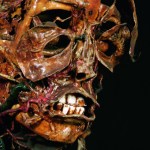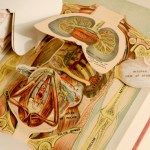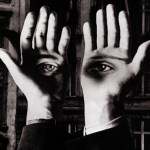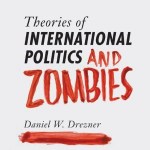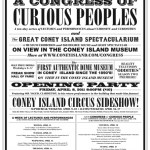Science in Culture & Policy
In a guest post at Scientific American, Rebecca Jablonsky says,
Kuhn de-legitimized the understanding of science as implicitly including objective reality, leaving room for theory to de-stabilize rituals of practice and produce authentic innovation-something that is certainly prized in both artistic and scientific communities alike.
Seriously - go read it and come back. It's short. I'll wait.
So I don't get it. While Jablonsky's post is well-written and thoughtful, and I basically agree with everything she says, and find the concepts interesting, I can't figure out who the post is intended to…
What with all the buzz surrounding Bjork's Biophilia project, science films are so hawt right now! Don't know what I'm talking about? Then check out this weirdness:
Yeah. . . okay!
Anyway, some other science/film folks, the crew over at Imagine films, reached out to ask me to remind you that the deadline is approaching for your science films to be considered for this year's festival:
We are currently looking for short or feature length films to showcase at this years festival. Submissions should weave elements of real science into a fictional narrative and filmmakers from all backgrounds are…
. . . they could have. Or pretty darn close, at least - they just needed to visit one of the many European cabinets of anatomical curiosities, to see the work of anatomists like Honore Fragonard.
Fragonard's eighteenth-century ecorches were the clear precursors to Gunther von Hagens' "Body Worlds" exhibits: preserved, injected, partially dissected bodies in lifelike, dramatic poses, with ragged strips of muscle draped like primitive clothing over exposed vessels and nerves. The effect is eerie - like a Vesalius illustration sprung to (half-)life:
Man with a Mandible
Several of Fragonard's…
A CSPO webcast entitled "New Tools for Science Policy" asks an interesting, if somewhat odd, question about science and art: "Can art and religion serve as methods for governing emerging science and technology?"
More details:
Tuesday, May 24, 2011, 5:30 p.m. EDT (webcast will be here)
Participants:
Dr. Greg Graffin, Recent author of Anarchy Evolution, professor of evolutionary biology at Cornell University, and lead singer of Bad Religion, one of the most successful punk rock bands in the world.
Steve Olson, Co-author with Dr. Graffin of Anarchy Evolution, freelance writer, and former Special…
Animated Anatomies, a new show at the Perkins Library at Duke University, explores the tradition of fold-out or pop-up paper anatomical diagrams:
Animated Anatomies explores the visually stunning and technically complex genre of printed texts and illustrations known as anatomical flap books. These publications invite the viewer to participate in virtual autopsies, through the process of unfolding their movable leaves, simulating the act of human dissection. This exhibit traces the flap book genre beginning with early examples from the sixteenth century, to the colorful "golden age" of…
I was playing The Fracking Song last night about midnight, and my boyfriend was grooving to it. At the end he asked, "what was that about?" "Uh. . . fracking."
"Which kind of fracking?"
Yes, we are a BSG household.
Anyway, it may be an explainer, but it's actually quite a nice little piece of music too. And I'm a sucker for good typography any day.
Is your fracking attention span longer than 2:33? Then go dig around in ProPublica's fracking investigation. "The Fracking Song" is by members of Jay Rosen's NYU graduate journalism class. Nice work, guys!
Miracle of Science: the Cambridge bar around the corner from MIT, where the menu is a (pseudo) periodic table. May I recommend the grilled chicken salad with cilantro lime dressing, "Sc"?
So I ran across this thread, and it made me sad. (And no, not because it wasn't Ed Yong's blog, although that too.)
It started off as a happy post: the author, Paula Chambers, is a PhD who began her own online community for PhDs seeking jobs outside academia. That's awesome. But when Chambers went to hire an assistant, and received applications from fellow PhDs (and ABDs - "all-but-dissertation" scholars), she was not impressed:
I was and remain astounded by the failure of so many smart, educated people to follow instructions. It wasn't complicated. I asked for a résumé, cover letter, and…
Now this is just cruel: yesterday the Cambridge Science Festival kicked off - a week of science, sciart, sci-journalism and sci-education activities at MIT, Harvard, the Museum of Science, and surrounds. Am I going to be hanging out all day with my fellow-geeks in the sun (which finally came out a few days ago, right on cue)? No! Because I have to write two final papers. (At least they're about sci-law. . . )
Anyway, don't be like me. If you're in the Cambridge/Boston area, have a life and check out the Cambridge Science Festival schedule. There are talks, performances, screenings, panels,…
"Reasoning was not designed to pursue the truth. Reasoning was designed by evolution to help us win arguments."
- Jonathan Haidt, "The New Science of Morality",
invoking the work of H. Mercier and D. Sperber.
(the whole talk is really interesting).
Adam Winnik sent me this animation inspired by Carl Sagan's famous "pale blue dot" monologue. It's true to the serious implications of Sagan's words, yet wry and lighthearted (mostly). A lovely example of remix culture revitalizing a classic of biology.
Adam gives some background:
I've been enrolled in illustration at Sheridan College for the the last 4 years and this is my final thesis project. I have always thought of Carl Sagan's writings as "scientific poetry" since they lack the cold touch that science is often cursed for having. I think Sagan's words resonate more than ever, and will…
At the moment, a few blocks away, a few of my friends are attending a Science and Technology Studies (STS) conference at the Harvard Kennedy School. I have no idea what they're doing, although I'm sure it's very smart. I'm only here to tell you they have THE CREEPIEST POSTER I have ever seen for an academic conference:
I'm just saying, STS is definitely humanities, not science. (Now I have to run away before my boyfriend retaliates). When did you last attend a scientific conference with a vintage, artsy, creepy poster by the last surviving member of the Bauhaus? Nice work, Alex Wellerstein.…
While we're on the bioanimation topic, I recently heard from Jess at Nervous System, who sent me links to some animations of their new jewelry line, hyphae, "growing" in virtual space. Check it out:
Hyphae - growth of the Vessel Pendant from Nervous System on Vimeo.
They explain,
Hyphae is a collection of 3D printed artifacts constructed of rhizome-like networks. Inspired by the vein structures that carry fluids through organisms from the leaves of plants to our own circulatory systems, we created a simulation which uses physical growth principles to build sculptural, organic structures.…
Wait - did Peter Nowogrodski just shoehorn everything I love into one meandering, indulgent multimedia essay??*
Tolkien's Shire appears as a coherent ecosystem, cradled by productive fields and populated by abundant orchards, caches of edible mushroom, and even the fishable Bywater Pool, ornamented with an authentic churning mill. The land at Hobbiton is changing still: Jackson's crowning oak tree now sits in sun-scarred pieces behind a rotten wooden fence at the termination of Bagshot Row, a home for the welcome swallows that course through air above. In the pastures opposite Bag End, a…
Wow - my post about unhappy bio grad students is getting massive traffic. (Hi SlashDotters and StumbleUpon-ers!) Mike the Mad Biologist, my original inspiration, has responded here and here to all the buzz.
I pretty much said everything I wanted to say in the original post, and I don't pretend to have an explanation or cure for this problem. But I see that there's been some snarkiness on the intertubez (shocking!!!) while I was away watching the developments in the Myriad appeal. So I want to clarify two points.
First, let me emphasize that I'm not saying graduate students in other fields don…
The oral arguments in Monday's Myriad appeal are online here. (Scroll down and look for Association for Molecular [Pathology] v. PTO).
Tomorrow morning, a three-judge panel of the Court of Appeals for the Federal Circuit will hear arguments in the appeal of Association for Molecular Pathology v. U.S. Patent and Trademark Office - better known as the Myriad gene patent case.* It has the patent and genetic blogospheres in a bit of a tizzy, and the mainstream media is picking up on it too. See, for example, this Atlantic article by Andrew Cohen, this Nature.com editorial by my friend Shobita Parthasarathy, and even a "Spectator's Guide to the Myriad Oral Argument" by Genomics Law Report -- which has a dedicated icon and…
It's the very last installment of Zombiefest - one more book review, this time for one I heartily recommend!
Daniel Drezner, a professor of international politics at Tufts, prefaces his new book about zombies with an unexpected vignette - a visit to Graceland:
By the time my tour hit the Jungle Room, it was obvious that the thirty-odd people walking through Elvis Presley's mansion fell into two groups. The first contingent was thoroughly, utterly sincere in their devotion to all things Elvis. They were hardcore fans, and Graceland was their Mecca, their Jerusalem, and their Rome. . . the…
The myriad miseries of graduate school are reserved to no one discipline, but there may be something to the contention that biology graduate programs are particularly bad. Here's what Mike the Mad Biologist says, in response to Science Professor, and I think he's quite right:
The basic problem stems (so to speak) from too many biology Ph.D.s and not enough funding, leading to an immensely cutthroat environment--and one that is psychologically damaging to boot. . . .So why does this dysfunctional cultural paradigm exist? I think it has to do with two things: specialization and Ph.D. training…
The 2011 Congress of Curious Peoples, featuring, among other guests, Anna Maerker, author of Model Experts: Wax Anatomies and Enlightenment in Florence and Vienna, 1775-1815; Mike Sappol, author of A Traffic of Dead Bodies: Anatomy and Embodied Social Identity in Nineteenth-Century America; Elizabeth Stephens, author of Anatomy as Spectacle: Public Exhibitions of the Body from 1700 to the Present; and John Troyer, author of Technologies of the Human Corpse (forthcoming). Whoa.
Learn more here!
